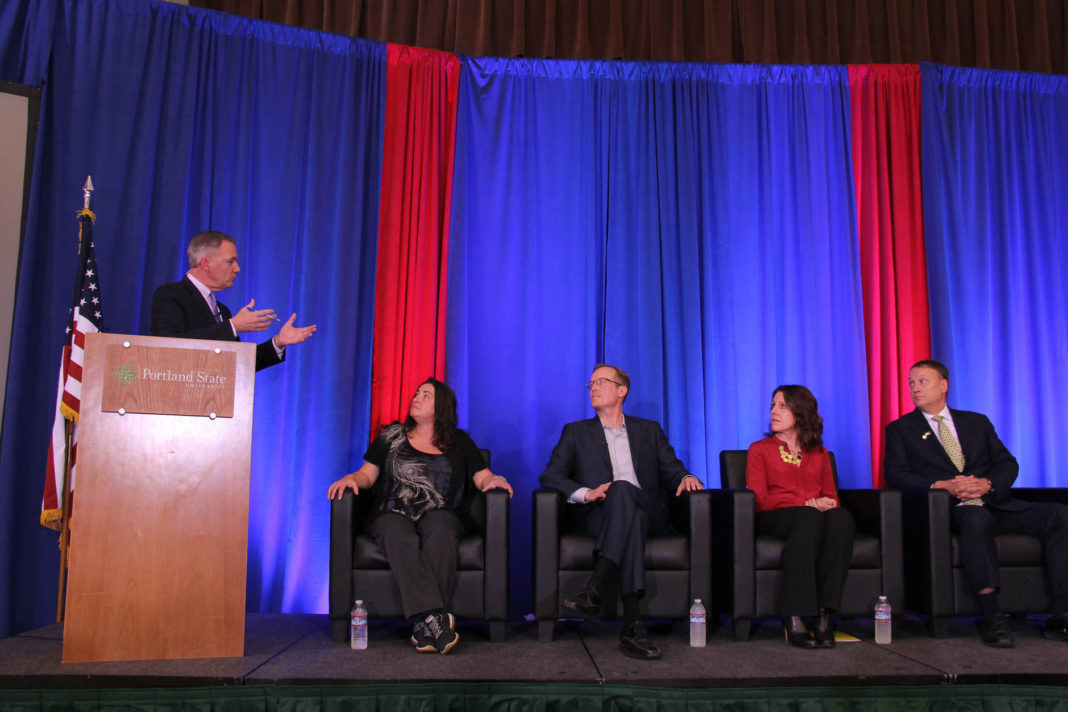Bernstine announces budget meeting
A mood of anxiety pervades the campus after President Daniel Bernstine called for a campus-wide convocation on the university’s financial shortfall and more than 300 faculty and staff members have received notices of potential layoffs.
No actual terminations have been ordered. They would result in termination as of June 30 followed by failure to reappoint.
Bernstine will address this and other aspects of meeting the crisis in his special convocation Thursday, Jan. 16, at 4 p.m. in the Smith Memorial Student Union ballroom.
All fixed-term (non-tenured) faculty and staff received these notices of potential layoffs earlier in December to conform to requirements of the American Association of University Professors collective bargaining agreement.
Cathy Dyck, associate vice president for Finance and Administration, said all fixed-term employees, a total of 330, received the letters. These came in addition to other “automatic” letters that had gone out to certain employees hired on “soft funding.”
The soft-funding category includes funding dependent on year-to-year allocations, such as grant money and student-fee funding. In total, 447 employees are on notice they may not be reappointed.
Bernstine revealed his plans to deal with the budget crisis in a letter, which employees received with their paychecks Dec. 31. Forewarning of the potential layoffs came in a story in the Dec. 4 issue of Currently, the weekly publication produced by Kathryn Kirkland, editor in the office of publications.
Bernstine’s letter, dated Dec. 30, said, “Just this month PSU was directed to take an additional $1.7 million reduction, on top of a mid-biennium cut we took earlier of $7.6 million. We have also been informed that we may face another $5.6 million cut in January if new revenues are not provided, bringing our total reduction in 2001-03 to $14 million or 10.4 percent of our state appropriation.
“In addition we must be prepared in the event that more revenue is not provided for and the economy continues its downturn.”
Bernstine wrote that his presentation this month will focus on the budget planning process PSU will employ to find creative solutions to uphold the university’s mission. The process will involve the campus community, he promised.
His goals, he wrote, go beyond protecting the university’s mission. He wants to address budget reductions in a way that protects as many individuals as possible and provides the flexibility to manage additional cuts if necessary.
In part, he continued, that was why cuts have focused mostly on administration and reducing fund balances.
He referred to layoffs, which caused a stir when they occurred somewhat abruptly last May. These layoffs fell most heavily on non-faculty areas, such as facilities.
However, he continued, “further state reductions now require that we examine more broadly all areas of the university.”
Dyck emphasized that nobody has been laid off yet.
She said the university already is operating under a $7.8 million deficit, with the threat of an additional $5.6 million if this month’s election turns down the proposed income-tax surcharge. The new additional $1.7 million mentioned by Bernstine provided just the latest shock.
Making up these deficits only carries PSU through the biennium ending this June 30, Dyck emphasized.
“Nobody knows what the next biennium will bring,” she said. Much of that will be up to the next Legislature, which convenes this month.
The fact that only fixed-term faculty and staff received warnings of intent not to renew does not mean other areas of the university may not also become subject to layoffs.
“Classified employees could get 30 days notice,” she said, as union contracts require. Some administrative personnel could be terminated with very short notice.
“We are all working on this, doing the best we can with what we have to work with,” Dyck said.
The total numbers of potential layoffs available did not reflect how layoffs might eventually affect individual departments.
“That is left up to the deans,” Dyck said. She said it is hoped the cuts will not result in a reduction in number of classes offered.
“We want to do cuts that won’t directly affect enrollment,” she said. “If we lower enrollment, the money we receive from the state goes down.”
Dyck predicted there will be a committee formed composed of union representatives, faculty, staff and students.
“The committee will be looking at how we go ahead making cuts for next year,” she said.
In his letter, Bernstine expressed regret for the impact of the notices to fixed-term faculty.
“We know these notices were upsetting to receive, but they were necessary for the university to comply with the notice requirements specified in the promotion and tenure guidelines and the AAUP Collective Bargaining Agreement,” he wrote.
“I want to emphasize that these notices were sent to maintain flexibility in budgetary times that are different from any PSU has experienced in the past. These times are certainly extraordinary and affect all of us,” he continued.
In her publication, Kirkland reported the university had already made total cuts of $7.1 million since the 2001 biennium and the summer special sessions of the Legislature had resulted in even more reductions than previously anticipated.



